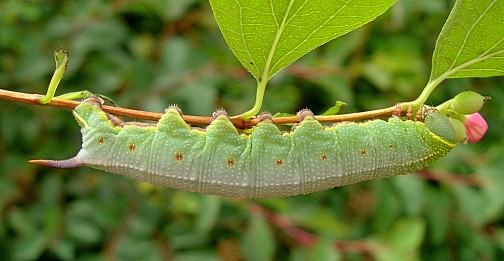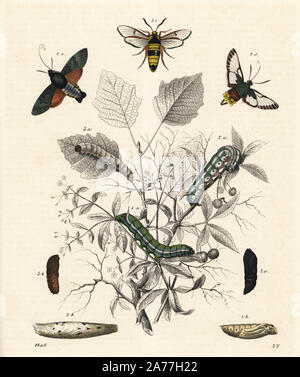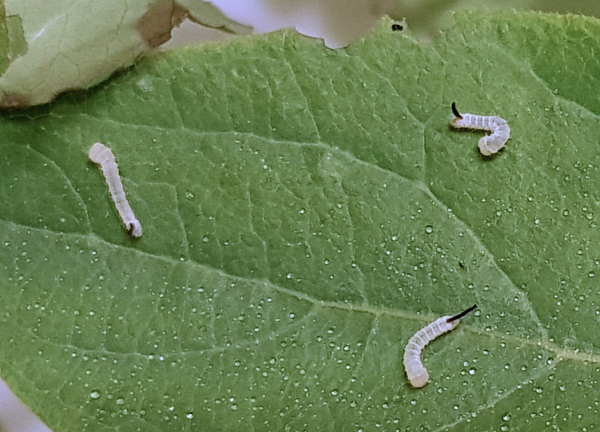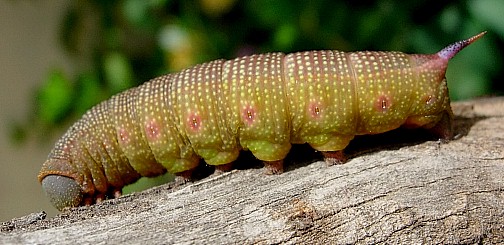78 Amazing Hemaris Fuciformis Larvae
Hemaris fuciformis larvae Hemaris fuciformis minor Lambillion 1920. The wingspan is 3848 millimetres 1519 in.
 Hemaris Fuciformis Broad Bordered Bee Hawkmoth Welcome Visitor
Hemaris Fuciformis Broad Bordered Bee Hawkmoth Welcome Visitor
A not so common species throughout Belgium more observations in the northeastern part of the country.

Hemaris fuciformis larvae. According to Degtyareva Shchetkin 1982 the fully-grown larva resembles that of Hemaris fuciformis. The moth flies from April to September depending on the location. Larvae consume copious amounts of foliage and when they are ready they climb down their host plant and burrow underground where they pupate. Hemaris fuciformis larvae
Eggs markedly flattened to not flattened spheroidal. Ottonis is recognized for the first time as Weigela praecox Caprifoliaceae. Hemaris fuciformis obsoleta Lambillion 1920. Hemaris fuciformis larvae
ES Koshkin SI Yevdoshenko Journal of Asia-Paci fi c Biodiversity 1 2 2019 6 13 e 625 621. An identification key redescriptions distributions and overviews of the ecology of Hemaris species in the Russian Far East are provided. Broad-bordered Bee Hawk-moth Hemaris fuciformis Linnaeus 1758 Wingspan 40-47 mm. Hemaris fuciformis larvae
The pupa is dark brown in color quite slender. The wings are covered with very loose grey scales on the freshly emerged moths. Hemaris fuciformis has a very easily recognisable feeding pattern. Hemaris fuciformis larvae
Eggs are small spherical and pale glossy green in color. 4 male pupae normally 2156 NOW 1795. The larval host plant of H. Hemaris fuciformis larvae
It is found in North Africa Europe except northern Scandinavia and central and eastern Asia. Broad-bordered Bee Hawk Hemaris fuciformis. Ottonis have been studied for the first time. Hemaris fuciformis larvae
Haemorrhagia fuciformis circularis Stephan 1924. Hemaris fuciformis is locally endangered due to darkening processes in the forests dense continuous reforestation eutrophication directly adjacent coatless intensive agricultural areas forest-pasture separation and on grasslands by sometimes to radical bush removal. During the winter keep the dormant pupae cool. Hemaris fuciformis larvae
The pupa is enclosed in a loosely spun cocoon and is glossy in most species. When they fly the scales are flung off leaving clear areas more like the wings of bees and wasps. The larvae are small cylindrical and covered in granules that often have small bristles. Hemaris fuciformis larvae
All have a distinctive pale dorsolateral longitudinal stripe from head to horn. The larvae are small cylindrical and granulose. The larvae feed on honeysuckle and Galium species and the moth flies from April to September depending on the location. Hemaris fuciformis larvae
Browse the list of datasets and find organisations you can join if you are interested in participating in a survey for species like Hemaris fuciformis Linnaeus 1758. I Although very close recent DNA barcoding studies have demonstrated that Hemaris fuciformis jordani Clark 1927 from Morocco and. This bee-like moth is a day-flying species preferring open woodlands and clearings and appears in May and June. Hemaris fuciformis larvae
When they fly the scales are flung off leaving clear areas more like the wings of bees and wasps. When the larva hatches from its egg it will choose a leaf and will stay there under the midrib eating small holes upward through the leaf. 4 male pupae normally 2156 NOW 1795. Hemaris fuciformis larvae
April 14 2020 1055 am. After each meal it chooses a new area of leaf making another small hole. Hemaris fuciformisA fi fth instar larva. Hemaris fuciformis larvae
Narrow-bordered Bee Hawk Hemaris fuciformis Broad-bordered Bee Hawk Hippotion celerio Silver-striped Hawk. We believe this is a Broad Bordered Bee Hawkmoth Hemaris fuciformis and not Hemaris thysbe. Hemaris fuciformis known as the broad-bordered bee hawk-moth is a moth of the family Sphingidae. Hemaris fuciformis larvae
The wings are covered with very loose grey scales on the freshly emerged moths. Broad-bordered Bee Hawk Hemaris fuciformis. Smooth or minutely pitted. Hemaris fuciformis larvae
Datasets have provided data to the NBN Atlas for this species. The granules often have small bristles. Most larvae are green brown and gray but there are many color forms. Hemaris fuciformis larvae
When attacked by predators the seemingly defenseless bee hawk moth larva regurgitates a sticky toxic substance from their gut onto their attacker. The adults emerge in June. The morphology and biology of preimaginal stages of H. Hemaris fuciformis larvae
Bee hawk Hemaris fuciformis. Hemaris fuciformis jakutana Derzhavets 1984. Hemaris fuciformis Larvae of North-European Lepidoptera Kimmo Silvonen Hemaris fuciformis Svenska fjärilar SVF Hemaris fuciformis fuciformis Sphingidae of the Western Palearctic Tony Pittaway Hemaris fuciformis fuciformis Sphigidae of China and adjacent regions Tony Pittaway. Hemaris fuciformis larvae
The adult bee hawk moth is extremely quick and agile in flight. Dorsally and laterally pale green in the green form with a prominent yellowish white dorso-lateral line running from the first thoracic segment up to a slightly curved caudal horn. The young larvae create small circular holes in honeysuckle leaves resulting in a distinctive feeding pattern and this. Hemaris fuciformis larvae
The pictured brown form of Hemaris fuciformis caterpillar was spotted in Lefokastro settlement Pagasitikos gulf Greece. Hemaris fuciformis Linnaeus 1758 Species Last modified. Eggs larvae and pupae. Hemaris fuciformis larvae
However unlike Hemaris fuciformis Hemaris ducalis bears a line of pale yellow V-shaped markings dorsally one per segment but less pronounced on the thoracic segments all pointing caudad. Hemaris fuciformis known as the broad-bordered bee hawk-moth is a moth of the family Sphingidae. The adults emerge in June. Hemaris fuciformis larvae
During the winter keep the dormant pupae cool. While most larvae are green and brown many color forms exist. Hemaris fuciformis larvae
 Latest Macro Photos Suffolk Moths The Macro And Micro Moths Of Suffolk Suffolk Moths The Macro And Micro Moths Of Suffolk
Latest Macro Photos Suffolk Moths The Macro And Micro Moths Of Suffolk Suffolk Moths The Macro And Micro Moths Of Suffolk
 Pdf Diversity And Ecology Of Hawk Moths Of The Genus Hemaris Lepidoptera Sphingidae Of The Russian Far East
Pdf Diversity And Ecology Of Hawk Moths Of The Genus Hemaris Lepidoptera Sphingidae Of The Russian Far East
 Narrow Bordered Bee Hawkmoth Larva Hemaris Tityus Feeding Stock Photo Alamy
Narrow Bordered Bee Hawkmoth Larva Hemaris Tityus Feeding Stock Photo Alamy
 Broad Bordered Bee Hawk Moth Moth Hawk Moth Insects
Broad Bordered Bee Hawk Moth Moth Hawk Moth Insects
 Sphingidae Of The Eastern Palaearctic Hemaris Fuciformis Fuciformis
Sphingidae Of The Eastern Palaearctic Hemaris Fuciformis Fuciformis
 Hemaris Fuciformis Broad Bordered Bee Hawkmoth Larva Flickr
Hemaris Fuciformis Broad Bordered Bee Hawkmoth Larva Flickr
 Hummingbird Hawk Moth Macroglossum Stellatarum 1 Broad Bordered Bee Hawk Moth Hemaris Fuciformis 2 And Hornet
Hummingbird Hawk Moth Macroglossum Stellatarum 1 Broad Bordered Bee Hawk Moth Hemaris Fuciformis 2 And Hornet

Broad Bordered Bee Hawk Moth Hemaris Fuciformis Niclas Ahlberg Nature Photography
European Lepidoptera And Their Ecology Hemaris Tityus
 Diversity And Ecology Of Hawk Moths Of The Genus Hemaris Lepidoptera Sphingidae Of The Russian Far East Sciencedirect
Diversity And Ecology Of Hawk Moths Of The Genus Hemaris Lepidoptera Sphingidae Of The Russian Far East Sciencedirect
 Nature Picture Library Portrait Of Adult And Larvae Of The Broad Bordered Bee Hawk Moth Hemaris Fuciformis And Narrow Bordered Bee Hawk Moth H Tityus By August Johann Rosel Von Rosenhof From
Nature Picture Library Portrait Of Adult And Larvae Of The Broad Bordered Bee Hawk Moth Hemaris Fuciformis And Narrow Bordered Bee Hawk Moth H Tityus By August Johann Rosel Von Rosenhof From
 Hemaris Fuciformis A Fifth Instar Larva B Pupae Photos By S Download Scientific Diagram
Hemaris Fuciformis A Fifth Instar Larva B Pupae Photos By S Download Scientific Diagram
Lepidoptera Mundi Hemaris Hemaris Fuciformis Linnaeus 1758
Hemaris Fuciformis Broad Bordered Bee Hawk Moth
European Lepidoptera And Their Ecology Hemaris Fuciformis



